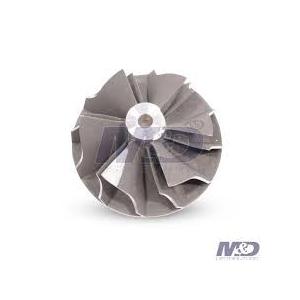
Add to Cart
Eliminated Surging Turbo Compressor Wheel 9 Bladed Extended Tip Reduces Visible Emissions
1 More rugged and reliable
2 High torque output hence pulling power is high
3 Gears are tall
4 Fuel efficiency is high
5 Service requirement is less frequent
Turbocharger is an integral umpart of the ship's marine engine as it reuses the exhaust gases in order to increase the overall efficiency of the engine. It consists of two parts – blower and turbine sides, which need equal attention while carrying out routine maintenance procedures.
Turbocharging is one kind of supercharging by using exhaust gas turbocharger. In which the energy in the exhaust gas expelled from the engine cylinder is utilized in driven in gas turbine, which is connected to a centrifugal air blower and air is supplied to scavenge air trunk.
Turbocharger design features:
Turbo compressor impeller (also called compressor wheel) belongs to one part of turbocharger with the design features as below:
Supercharger is a axial-flow turbocharger.
Turbochargers adopts inboard plain bearing, uncooled casings and lubricated by the engine's lube oil system.
For engine power output range from 1,650 to 24,500 kW per turbocharger;
Axial flow turbine inboard plain bearing design;
Lubricated by the engines lube oil system;
Suitable for a wide variety of fuels, heavy fuel, diesel oil, biofuel and gas operation;
Simple and durable design;
| Model: | Turbo Compressor Impeller | Product Name: | Turbocharger Compressor Wheel, Marine Turbo Compressor Impeller |
|---|---|---|---|
| Type: | Exhaust Gas Turbocharger | Engine Type: | Diesel, Biofuel And Gas Engines |
| Engine Power Range: | 1650 KW -24,500kW | Bearing Design: | Inboard Plain Bearing Design |
The description of turbo compressor impeller:
The turbo compressor impeller (compressor wheel) is of aluminium alloy or the more expensive titanium. Manufactured from a single casting, it is located on the rotor shaft by splines.
Aluminium impellers have a limited life, due to creep, which is dictated by the final air temperature. Often the temperature of air leaving the impeller can be as high as 200°C.
The life of the impeller under these circumstances may be limited to about 70000 hours. To extend the life, air temperatures must be reduced. One way of achieving this is to draw the air from outside where the ambient air temperature is below that of the engine room.
Efficient filtration and separation to remove water droplets is essential and the impeller will have to be coated to prevent corrosion accelerated by the possible presence of salt water.